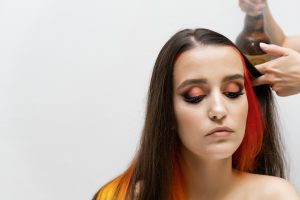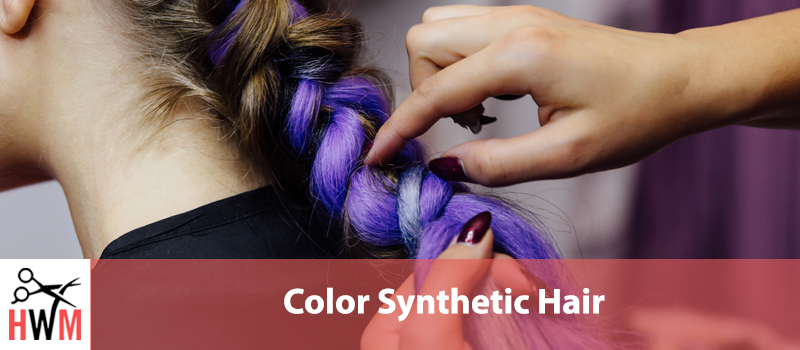Synthetic hair is an increasingly common accessory for men and women alike. More and more people are boasting synthetic weaves, extensions, and even full wigs. But, whether your hair is natural or synthetic, most people want to shake things up with the occasional change.
Unfortunately, synthetic hair usually has fewer styling options that natural hair. Cutting is difficult and can highlight the unnatural fibers. But, can you color synthetic hair?
Well, the truth is, yes. You can color synthetic hair. In fact, we’re going to give you a few options for how to color synthetic hair.
Fair warning. Synthetic hair is Not designed to be colored and coloring your synthetic hair will shorten it’s life and can render it unusable. If you want to experiment with coloring your synthetic hair we recommend starting with a wig or set of extensions that you aren’t hugely attached to.
Better yet, have a replacement on hand in case your synthetic hair doesn’t survive or comes out an unusable color.
Okay, now that we have those disclaimers out of the way, let’s take a look at how you can color synthetic hair!
- Reasons to Color Synthetic Hair
- The Rules of Dyeing Synthetic Hair
- How to Color Your Synthetic Hair
- Other Synthetic Wig Dyeing Methods
Reasons to Color Synthetic Hair

Synthetic hair comes in a few different varieties. Most people are probably familiar with the cheap synthetic hair wigs you can buy at Party City right before Halloween or a birthday get-together.
There are also a lot of high-end wigs and weaves that use all synthetic or a mix of synthetic and natural hair. While most people don’t want to dye their high-end wigs, those things are expensive after all, there will always be some room for experimentation.
Most synthetic hair wigs (and the same goes for extensions and weaves, but we’re mostly going to talk about wigs in this article) are only good for about 4-6 months. If you don’t take care of your wig, buy a heat-resistant wig and style it frequently, or color your wig, that life will be shorter.
One reason you might want to color a wig is that it’s at the end of its life anyway, you already have another one, and just want to have some fun and see what cool new style you can come up with.
Another common reason is to expand the variety in your wig collection. Especially if you have a combination of costume wigs and high-end wigs, it may be reasonable to color one or two for a little more variety in your day to day.
Synthetic extensions are a cheaper way to get some color and variety in your hair. Plus, extensions are less expensive than wigs, so the risk of losing a set of extensions is less daunting.
The last and most common reason to try hand-dyeing synthetic wigs is for cosplay. Getting the perfect wig color for your favorite character can be difficult. Worse, you might still find yourself with the wrong color, even when you pay for custom dyeing and styling.
Taking care of the dyeing process yourself gives you a little more control. Plus, since most synthetic wig dyeing methods are highly affordable, it usually costs less overall. Combine that with a little styling knowledge, and you can potentially take a cheap, low-end wig and end up with the perfect costume accessory.
Regardless of your reasons, it’s important to be careful and patient when you’re dyeing synthetic hair. Synthetic hair isn’t like natural hair and can’t do everything a natural wig can do. Take your time, go slow, and start with a wig or set of extensions that you don’t mind losing.
The Rules of Dyeing Synthetic Hair
Even if you’re experienced dyeing your own hair, or dyeing and styling natural hair wigs, the rules for synthetic wigs are very different.
Don’t Bleach Your Synthetic Hair!
Synthetic hair can only be dyed darker, it can’t be bleached or otherwise lightened. Fortunately, that isn’t because the synthetic hair will react with bleach or any other potentially dangerous interaction.
It’s simply because synthetic hair will not lighten when exposed to bleach. You may damage the fibers a little in the process, but you won’t strip the colors out of them.
In natural hair, bleach works by opening the hair cuticle and drawing out the color. Since synthetic hair fibers are completely impregnated with color and don’t have cuticle to open, bleach doesn’t have a way to work. In fact, many people use mild laundry bleach solutions to clean and sanitize their synthetic hair wigs!
Come to the Dark Side
Because you can’t bleach or otherwise lighten a synthetic wig, you’ll need to look for darker color options.
Just like in natural hair, it may be difficult to dye synthetic hair that’s already a dark color. If your wig is black, or a dark brown, you may want to buy a lighter wig before attempting to color it.
Since synthetic wigs come in a wide variety of colors, we recommend buying a wig that is blonde at the darkest. White and silver wigs can also be dyed, as can pastel wigs. But white and silver wigs are difficult to dye a natural color.
Pastel wigs almost certainly can’t be dyed a natural color and will look best if you dye the same color family as the original. So, pink wigs could potentially be dyed red, orange, or even purple, but you shouldn’t try to dye a pink wig green.
Anime Hair is Your Friend
While you can achieve a natural-looking dye job, it’s difficult. The naturally occurring colors in your hair are much more complex than you’d expect.
If you’ve ever done a full face of makeup with color correction and contour, you probably have a good sense of how seemingly random colors like green, purple, and red, come together to create a natural look.
The same if you’ve ever watched someone mix a custom foundation. A good color match involves a lot more than peach, tan, brown, red, and pink.
Your hair is no different. Not to mention that your hair isn’t one single color. It isn’t even just three, though we tend to talk about hair as a main color, a highlight, and a lowlight. Natural hair has dozens of colors, and no two strands are exactly the same. Most of your hair will even have slight color variations in a single strand.
So, instead of trying to mimic all that variation, synthetic wigs tend to look best if you go the opposite direction and embrace the full rainbow of unnatural colors.
If you choose an unnatural color, you’ll also be playing to one of the weaknesses of synthetic hair and turning it into a strength. Synthetic hair tends to have higher gloss than natural hair, giving it away even when it is a natural color. But no one will think twice about a little extra gloss on a bright purple head, or a green one, or a ruby hairstyle.
Pastels, Anyone?
Another tip is to aim for more of a pastel than a jewel tone. Pastels are easier to achieve, easier to blend, and easier to maintain than brighter colors. They’re also usually less likely to transfer onto your skin or clothes after dyeing.
While you may want to switch to a brighter color palette after you’ve dyed a few synthetic hair wigs or extensions, starting in the pastel range will help you turn out beautiful dye jobs instead of ruined wigs. You’ll also develop a better sense of what freshly dyed synthetic hair looks like, vs the finished product.
Don’t Use Natural Hair Dyes
This is the second reason it’s difficult to create a natural-color dye job in synthetic hair. Most synthetic wigs won’t take natural hair dye. Even if the synthetic hair does change colors, it may not be the color you want or expect.
There are a few reasons for this. The main one is that natural hair dye is designed to work on natural hair. That means using chemicals and colorants known to affect keratin and the other natural proteins in your hair.
Synthetic hair isn’t made from those same proteins, or in the same molecular arrangement.
If you’re lucky, your natural hair dye won’t affect the synthetic hair at all. If you’re unlucky, you may find yourself sporting a green or blue wig when you were aiming for brown.
The exception to this rule is unnatural color dyes. Hair dyes meant to turn your hair blue or green are more likely to give you the intended results since the colorants are usually more potent and more universally effective.
Still, we don’t recommend using natural hair dye unless you’re very comfortable with losing your synthetic wig to a bad result.
How to Color Your Synthetic Hair

While there are many types of synthetic hair you might be working with, we’re going to cover each dyeing method as if you were dyeing a wig. That’s for one simple reason. Wigs are about the most complex arrangement of synthetic hair you might work with.
These processes will work for weaves and hair extensions just as well. But you may not have quite as many steps to fully cover those types of synthetic hair because there is less hair involved, and it doesn’t have to be as complexly colored.
The Acrylic Ink Method
The acrylic ink method is one of the most common options for dyeing synthetic hair. You have a wide selection of inks to choose from and can easily create custom colors. It’s fairly simple, highly effective, and less likely to ruin your wig than other methods.
What You Need:
We recommend buying all of these products specifically for dyeing wigs. For one thing, you’ll use most if not all of the acrylic ink to dye one wig. For another, you won’t necessarily want to use spray bottles, aprons, and other household supplies for other tasks after using them to dye a wig.
Start by arranging the wig on your Styrofoam head. You can use a normal wig stand, of course, but a Styrofoam head seems to work better since you don’t have to worry about cleaning it after dyeing. You can also use the same Styrofoam head several times, just rinse them with water before putting on the next wig if it isn’t going to be a similar color.
Next, grab the ink, alcohol, and spray bottles. Even if you’re going for an unnatural color, we recommend using at least two colors of ink to create some variation and depth in the color. For instance, if you want a green wig, you can use two different greens, a green and a diluted blue, or a green and a yellow.
For most dyeing, you’ll mix the ink and the alcohol about 50/50 in the spray bottle. But, the more diluted the ink is, the more pastel the final color will appear.
Diluting acrylic ink takes some practice. You won’t always get a lighter pastel version of the original color. For instance, purples tend to dilute pink, unless you add some blue to balance them.
Primary colors usually stay fairly true to color, but greens can go either blue or yellow and so on. More complex colors like browns are a toss-up and can dilute true to color, or into any number of alternatives.
For your first wig, we recommend either sticking to a 50/50 mix for every color or adding more alcohol. If the wig turns out too light, you can always try again with a stronger color mix, but you won’t be able to lighten a color that turns out too dark.
Now that you have your dyes mixed, start by spraying your main color over the bulk of the wig. For this tutorial, we’re going to assume that you’re going for a solid color wig but using at least 2 different dyes for some slight variation.
Remember that your colors should be very similar to create a convincing dye job, even using unnatural colors!
Getting Started
Put on your gloves and apron, make sure your workspace is thoroughly covered so that you don’t have to worry about stray drips and start spraying your wig.
Spritz the first section of hair a couple of times, then work the hair with your hands or the comb. Working and moving the hair will help distribute the hair, and will also expose fresh hair for you to dye. Make sure you’re fully saturating the hair, and that you’re getting the dye on every strand.
Work your first color through the wig, starting up by the roots, and then down most of the length of the synthetic hair. The comb will become your best friend as you work in the longer parts of your wig since you can use it to lift and move the hair. Use your off hand to work the hair as well. Keep checking your work to make sure you haven’t missed any sections of hair.
Switching Colors (2nd Color and On)

After you have most of the wig covered, go ahead and switch dyes. You may want to leave the tips of the hair undyed, or mostly undyed.
Use the same method to spray the second dye into any undyed sections. After the whole wig is saturated, use your best judgment to mix the dyes. It’s a good idea to frame your face with both colors, one over the other, and to provide some highlights through the length of your wig as well.
If you’ve done this part properly, your wig is probably dripping. Go ahead and walk away and let it dry for a while. Synthetic hair tends to dry quickly, so it may only take an hour or so for your wig to be totally dry.
Finishing Up
Many people stop here. There’s no real reason to go further if this is a wig for cosplay or a costume, or is unlikely to see a lot of use.
However, if your wig looks good and will be used a lot, is longer, or you’re worried about color transfer, go ahead and rinse it in plain cold water. You’ll lose some color, but you’ll be less likely to suffer from color transfer later.
An Optional Touch
There’s also one more, optional, step if you want a more complex or professional looking finish.
For unnatural colors, you’ll need a sharpie in a similar, but darker, color. For natural or natural-ish colors, it may be better to use a Copic or other alcohol-based marker.
Starting with the bottom weft of the wig, use your alcohol-based marker to color in some roots. Use a cotton ball or Q-tip soaked in your isopropyl alcohol to help blend and move the dye a little for a more natural-looking transition.
Work your way up the wefts of the wig to the very top. If the top of your wig doesn’t use wefts (and most won’t) you’ll want to use hair clips to section the hair to color in the roots.
If you choose to add roots to your wig it will probably be the most time-consuming part of the whole process. You’ll also want to give your wig a couple of extra days to air out before you wear it since the smell of alcohol and alcohol-based markers will linger.
Other Synthetic Wig Dyeing Methods
There are several other synthetic hair dying methods. While we tend to have the most success with the acrylic ink method, others prefer to use a water bath, a hairdryer, hair dyes, and even food coloring to create their synthetic dyes.
Watercolor Hair – Using a Hair Dryer to Create and Set Colored Highlights

This method works best if you don’t want to dye the whole wig, but only want to add some highlights in one or more colors. We think this method looks very soft and blended, like a watercolor painting.
This is a variation on the acrylic ink method, so you’ll need all the same tools, plus a hairdryer.
Instead of saturating your wig and then letting it dry, you’ll color a small section of hair using only 1-2 sprays, and then use the hairdryer to speed up drying. Repeat until you’ve created a look you’re happy with.
We think that this method looks best with multiple colors, usually 2-3, and no attempt to make it look like a natural or pseudo-natural color.
Unlike the acrylic ink dyeing method, we’ve already talked about, your different colors don’t have to be similar, although they should look good next to each other and the base hair color of your wig.
Water (or alcohol) Bath Synthetic Hair Dyeing
Water bath dyeing seems to be a favorite of people who use hair dyes instead of acrylic ink or other color sources. We didn’t get much success with this method, but others have been very successful.
Water will dilute the color more completely and may prevent successful dyeing with acrylic ink dyes. Alcohol is necessary for acrylic ink baths, while water is better if you want to try hair dye.
Water also needs to be warm-hot, but alcohol-based dyes will work at room temperature.
You’ll need a water-tight container big enough to hold enough water to submerge your wig and 1-2 bottles of hair dye or 1-4 bottles of ink. From here on we’ll talk about the water and hair dye method, but the process is similar for ink and alcohol.
You can start with hot water from the tap for up to 2/3rds of the water. You will want to add some boiling water, the last third, but be careful to keep the temperature of the water below your wig’s heat resistance.
The less water you use the less dye you’ll need. Try to estimate how much water you’ll need to completely submerge the wig and don’t use any more.
Add the dye to the hot water. 1 bottle is plenty for a lighter pastel color, but you may want to add another bottle if you want a darker color. Mix the dye into the water to make sure it’s evenly distributed. Make sure you’re using something you don’t mind being dyed, and that you won’t use in food later.
Submerge your wig, stir it around a little, and let it sit. The darker your desired color, the longer you should let the wig process. If you want a light color, aim for about 20 minutes of processing time. Darker colors can wait up to an hour, but you should check them every 20 minutes.
Pull the wig out of the dye bath and rinse it thoroughly to avoid color transfer onto your skin or clothes. That’s it! You’re done!
You can attempt the root dyeing method described above if desired, but the alcohol may change the color of some dyes. It’s a good idea to color test the process on a small hidden portion of the wig to make sure it looks the way you want it to.
Final Thoughts
Hopefully, now that you’ve read this article you feel a little more comfortable dyeing synthetic hair. There are lots of other methods out there, but we’ve tried to stick to the most consistent and low-risk options.
Dyeing synthetic hair is risky. It largely can’t be undone or corrected, and it takes some practice and know-how to get the colors right. But, if you have a wig or extensions you aren’t attached to and want to have a little fun, you now have the knowledge to pull it off!




